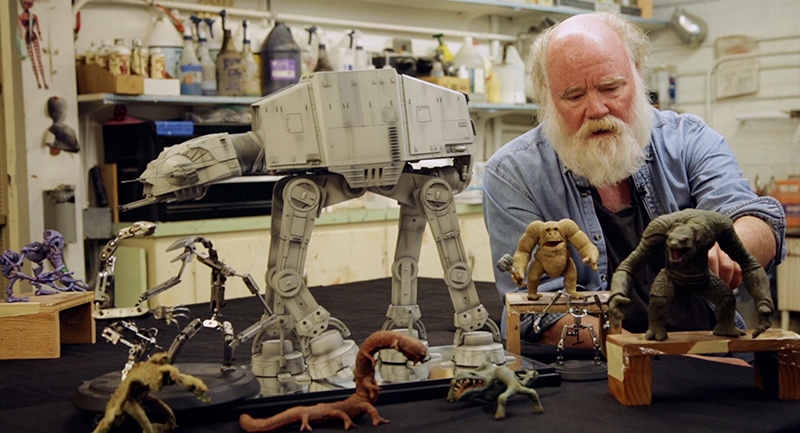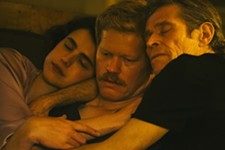Fantastic Fest Interview: Mad Dreams and Monsters
Inside the mind of stop motion wizard Phil Tippett
By Richard Whittaker, 12:59AM, Fri. Oct. 4, 2019

There is no more perfect art of cinema than stop motion. The idea of moving a model, one frame's worth of action at a time, then running the result at full speed to create impossible dreams? It blends art and science, and few creators ever reached the creative and technical summits of Phil Tippett.
French documentarians Alexandre Poncet and Gilles Penso have become the inadvertent chroniclers of the art. In 2011, they recounted the career of stop motion's second giant (after King Kong creator Willis O'Brien) in Ray Harryhausen: Special Effects Titan: four years later, they pulled the camera back for a broader view of practical monster effects with Creature Designers - The Frankenstein Complex. But now they have returned to a singular subject with the heir to O'Brien and Harryhausen.
Tippett came up as a young animator in California, working on commercials and small projects. His big break came in 1977 when he worked on his first feature, The Crater Lake Monster - and then went straight on to the set of a little film called Star Wars. What followed was a career that defined special effects in the 1980s and 1990s: the Star Wars films, RoboCop, Starship Troopers, Dragonheart. Alongside effects wizards Dennis Muren, Ken Ralston, and sound designer Ben Burtt, he defined an era of effects-driven movies.
Of course, the conventional wisdom holds that the CG revolution of Jurassic Park killed stop motion: but Mad Dreams and Monsters shows that modern cinema still has a lot to learn from a man who knows how dinosaurs hunt and dragons fly.
Austin Chronicle: Not many people make one documentary about special effects, never mind three.
Alexandre Poncet: It didn't start with a big plan. We didn't know for sure that we would do a documentary about Phil Tippett 10 years ago. When we did the Ray Harryhausen documentary, we did it because that film did not exist in the form that we wanted to see. Then we made The Frankenstein Complex, which was a step back and a look at the whole profession of creaturemaking. But it felt like a good, organic progression to go from Harryhausen to the whole profession to the heir to Harryhausen - which is Phil Tippett.
It felt relevant, because he had an important story that we needed to tell, and we could approach things that we had already dealt with in the previous films - like the Jurassic Park revolution - from a very different point of view.
Gilles Penso: Each film seems to be a crossover into the other. At the very beginning, the idea was a film about Harryhausen. We loved Harryhausen, we wanted to pay homage to him, and when the film was finished, all the studios welcomed us, and Alex started to do some interview with people, and that happened like that. When he said it was organic, it's exactly that. When we are finishing a film, we are already starting one, and sometimes we don't know we are starting a new one.
Even in Ray Harryhausen, we talk about the Jurassic Park revolution. Ray Harryhausen is talking about his point of view.
AP: That was the climax of the film.
GP: And in The Frankenstein Complex, a lot of people are giving their point of view, on how the business changed at that point. And now this is the end of the trilogy, as we tell that story from a personal point of view, and from a family - the point of view of his wife (Tippett Studios CEO Jules Roman), and of his best friend. So it's a way to close the chapter and go somewhere else.
AP: And we actually connected the three movies, because I wrote the music for all three. One of the main leitmotifs is the theme that I wrote for Harryhausen, and in The Frankenstein Complex, when they talk about Ray you hear his theme from the previous film; and in this one there are three instances where you hear the theme. The first time in the Piranha chapter, where they explain they wanted to do something like the Ymir from 20 Million Miles to Earth; then in the RoboCop chapter, there's a connection between Jason and the Argonauts and ED-209, so you hear the music; and at the very end of the end credits, the very final music you hear is a reprise of Ray Harryhausen's theme.
AC: One huge difference between this and the Harryhausen documentary is that there's an intimacy in the sequences with him. You can always feel his emotions very close to the surface, even as he says he doesn't like talking about the past. In those moments, you film him in very tight close-ups, and you let his face do all the communicating. When did you realize that what you were getting from Phil wasn't in what he was saying, but his appearance?
AP: It was the core of the project. It was the very first discussion that we had, that the face of Phil told the story more than what he said. The way he talks about his past is a paradox. Phil doesn't like to repeat the same story, which made it very difficult to make this film. We've known Phil for years, so we have a certain intimacy with him. We can spend dinners with him, arguing about things and discussing philosophical stuff and fighting, creating. It's about everything, but to be able to catch this on camera is difficult, because Phil in front of a camera has the reflex of not trusting the people leading the interview.
GP: And very quickly we understood with Phil that the silence would be as important as what he was saying. Because his face is very interesting to film ...
AP: It's a landscape.
GP: His face is like Rodin or Leonardo da Vinci.
But there are few moments in the film where a word is missing. He's talking about his childhood: he was shy with girls, he did not like sports, most of the time he was alone drawing. But he doesn't say that. He says, "Most of the time..." and he doesn't continue the sentence, but you can see him drawing. It's stronger than if he finished the sentence. For example, Jurassic Park, when he says, OK, that's the way we will do the film. He doesn't articulate that, OK, so now I'm not doing stop motion and that's a pity. He doesn't say anything, just, "OK, Steven [Spielberg] said we do the film like that," and we stay on his face as long as possible. These moments are very important.
AC: And it echoes what he does artistically, which is use the physical to tell a story. His creatures don't deliver dialogue. Everything is communicated in silent action. After all, a stop motion artist is a performer: they just use a creature's body for the performance.
AP: It's like an avatar.
GP: But what is strange is the Phil Tippett is not passionate at all. In stop motion, you have to be very passionate, and he's not. He wants to go straight to the point, and so his way to animate is to work very fast.
AP: And he's allowing himself to make mistakes, and those mistakes are texturing the result. They're not mistakes any more.
AC: One big difference between Harryhausen and Tippett that comes across is that Harryhausen never seemed particularly fond of people, and did as much as he could without any assistance or interference. By contrast, Phil seems much more collaborative.
GP: The story of cinema changed. When Ray Harryhausen worked, he could do every visual effect on his films alone - except for the last one, Clash of the Titans, and he didn't like the experience of working with other animators. He understood at that point that the industry had changed. And from Clash of the Titans and The Empire Strikes Back, it would never be possible again to work alone on visual effects.
I think Phil would love to work like Harryhausen: do everything by himself, take four months to do a sequence, but it's no longer possible. You have to be collaborative.
AP: Clash of the Titans was Ray's Jurassic Park, because Clash of the Titans was a movie from the past, and The Empire Strikes Back was the future, and he understood that he had no place anymore in this world. Phil, his collaborators and Jules brought him to understand that he needed to adapt to this new world. Without his collaborators, he would be like Harryhausen - doing nothing, an icon from the past - and that's the key. His entourage is very important.
.
Phil Tippett: Mad Dreams and Monsters
International Premiere
A note to readers: Bold and uncensored, The Austin Chronicle has been Austin’s independent news source for over 40 years, expressing the community’s political and environmental concerns and supporting its active cultural scene. Now more than ever, we need your support to continue supplying Austin with independent, free press. If real news is important to you, please consider making a donation of $5, $10 or whatever you can afford, to help keep our journalism on stands.
June 27, 2024
June 28, 2024
Fantastic Fest, Fantastic Fest 2019, Phil Tippett: Mad Dreams and Monsters, Alexandre Poncet, Gilles Penso, Star Wars, ILM, Dragonslayer, Ray Harryhausen









